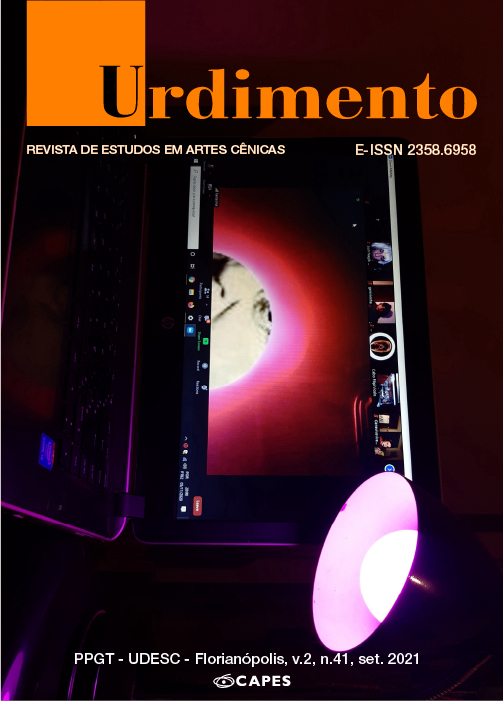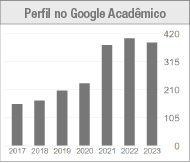La Nueva Mujer: Ansiedades masculinas y elusión femenina en el cabaret de Berlín
DOI:
https://doi.org/10.5965/1414573102412021e0105Palabras clave:
Nueva Mujer, Cabaret, Tipificaciones, República de WeimarResumen
La Nueva Mujer fue un fenómeno complejo, multidimensional, heterogéneo y gradual que ganó fuerza en Alemania durante la República de Weimar. El derecho a la participación femenina en la política garantizado por la Constitución de 1919 y la afluencia de mujeres al mercado laboral generaron tensiones masculinas sobre los roles de género. Cabaret trabajó como comentarista de su época y arrojó luz sobre las ansiedades masculinas con respecto a la Nueva Mujer, representándolas a través de tipificaciones. Este artículo pretende analizar algunas de estas tipificaciones - evidencia de las preocupaciones masculinas - en contrapunto a las estrategias femeninas para eludirlas.
Descargas
Citas
ANKUM, K. VON (org). Women in the metropolis: gender and modernity in Weimar culture. Berkeley: University of California Press, 1997. kindle edition
APPIGNANESI, Lisa. Cabaret the first hundred years. London: Methuen, 1984.
BAILEY, Peter. Conspiracies of Meaning: Music-Hall and the Knowingness of Popular Culture. The past and present society magazine. No. 144 (Aug, 1994), p. 138-170.
BOAK, Helen. Women in the Weimar Republic. Manchester: Manchester University Press, 2013.
BRECHT, Bertolt. The Messingkauf Dialogues. London: Methuen, 1994.
COHEN, Renato. Performance como linguagem: criação de um tempo-espaço de experimentação. São Paulo: Perspectiva, 2002.
DANIELCZYK, Sandra. Diseusen in der Weimarer Republik: Imagekonstruktionen im Kabarett am Beispiel von Margo Lion und Blandine Ebinger. Bielefeld: Transcript Verlag, 2017.
DOUBLE, Oliver; Wilson, Michael. Brecht and Cabaret. In: THOMPSON, Peter; SACKS, Glendyr. The Cambridge Companion to Brecht. Cambridge: Cambridge University Press, 2006.
FARINA, Willian. The German cabaret legacy in American popular music. Jefferson: McFarland & Company, Inc, 2013.
FECHNER, Charlotte. The Berlin Cabaret & the Neue Frau 1918-1933. München: GRIN Verlag, 2001.
FERRAN. Peter Wigglesworth. The Threepenny Songs: Cabaret and the Lyrical Gestus. Theater, Volume 30, Number 3, Fall 2000, pp. 5-21
GILL, Anton. Dance Between Flames: Berlin Between the Wars. Londres: Endeavour Press, 2015. Kindle Edition.
GORDON, Mel. Voluptuous panic: the erotic world of Weimar Berlin. Los Angeles: Feral House, 2006
GRAF, Rüdiger. Anticipating the Future in the Present: "New Women" and Other Beings of the Future in Weimar Germany. Central European History, vol. 42, no. 4, p. 647–673, 2009.
HAKE, Sabine. In the mirror of fashion. In: ANKUM, Katherine von (org). Women in the metropolis: gender and modernity in Weimar culture. Berkeley: University of California Press, 1997. kindle edition
LEWIS, Beth Irwin. Lustmord: inside the Windows of the Metropolis. In: ANKUM, Katherine von (org). Women in the metropolis: gender and modernity in Weimar culture. Berkeley: University of California Press, 1997. kindle edition
MAFESSOLI, Michel. O imaginário é uma realidade. Revista FAMECOS, Porto Alegre, nº 15, p.74-83, agosto, 2001.
MIZEJEWSKI, Linda. Divine Decadence: Fascism, Female Spectacle, and the Makings of Sally Bowles. Princeton: Princeton University Press, 2014, p.44
PAVIS, Patrice. Dicionário de Teatro. São Paulo: Perspectiva, 2008.
RICHARD, Lionel. Berlim, 1919-1933: a encarnação extrema da modernidade. Rio de Janeiro: J. Zahar, 1993.
RICHIE, Alexandra. Faust’s Metropolis: a history of Berlin. London: William Collins, 2013. Kindle Edition.
RUTTKOWSKI, Wolfgang. Cabaret Songs. Popular Music & Society, 25:3-4,
-71, 2001.
SCHASER, Angelika. Gendered Germany. In: RETALLACK, J. N. (ED.). Imperial Germany, 1871-1918. New York: Oxford University Press, 2008.
SCHMID, Carol. The 'New Woman' Gender Roles and Urban Modernism in Interwar Berlin and Shanghai. Journal of International Women's Studies, 15(1), 1-1, 2014.
SIEG. Katrin. Exiles, Eccentrics, Activists: Women in Contemporary German Theater. Ann Harbor: The University of Michigan Press, 1997.
SIMMEL, George. A Metrópole e a Vida Mental. In: VELHO, Otávio G (org.). O Fenômeno Urbano. Rio de Janeiro: Ed. Guanabara, 1973.
STREVA, Christina. Por um ator-provocador e um professor-criador: uma pesquisa-ação sobre a performance de cabaré. Tese (Doutorado) – Universidade Federal do Estado do Rio de Janeiro, Rio de Janeiro, 2017.
SUTTON, Katie. The Masculine Woman in Weimar Germany. New York: Berghahn Books, 2011.
TURNER, Victor. O processo ritual: estrutura e antiestrutura. Petrópolis: Vozes, 2013.
WIDDIG, Bernd. Culture and inflation in Weimar Germany. Berkeley: University of California Press, 2001.
Descargas
Publicado
Cómo citar
Número
Sección
Licencia
Derechos de autor 2021 Urdimento - Revista de Estudios en Artes Escènicas

Esta obra está bajo una licencia internacional Creative Commons Atribución 4.0.
Declaración de Derecho de lo Auctor
Los artículos publicados por la revista son de uso gratuito. Los derechos de autor son todos cedidos a la revista. Los artículos cuyos autores son identificados representan la expresión del punto de vista de sus autores y no la posición oficial de la revista Urdimento. El autor o los autores se comprometen a que publiquen material referente al artículo publicado en la Revista Urdimento mencionar dicha publicación de la siguiente forma:
"Este artículo fue publicado originalmente por la revista Urdimento en su volumen (poner el volumen), número (poner el número) en el año de (poner el año) y puede ser accedido en: http://www.revistas.udesc.br/index.php/urdimento
Este periódico utiliza una Licencia de Atribución Creative Commons - CC - BY 4.0.



